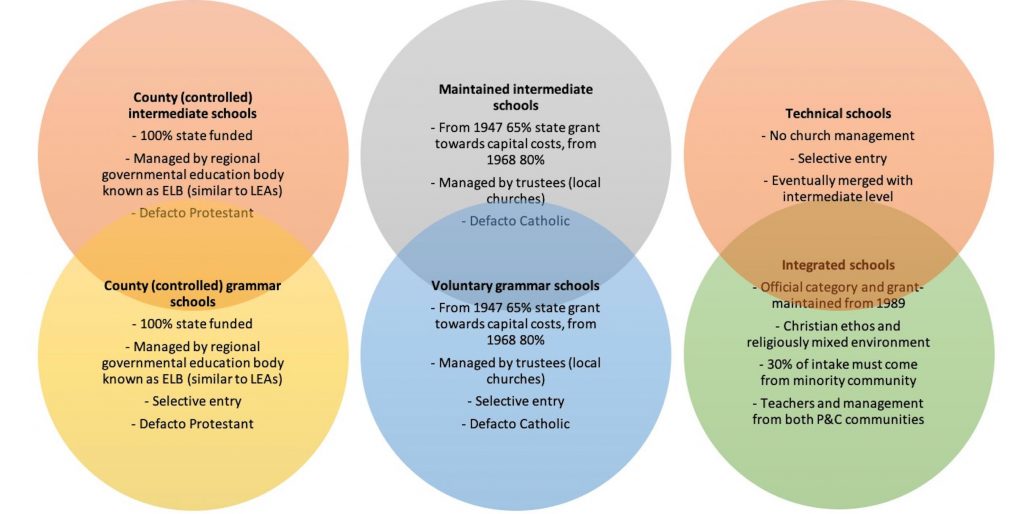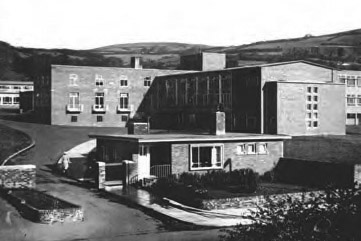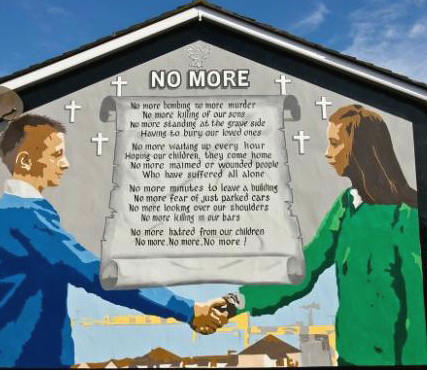By Peter Mandler //
The SESC project is moving into a new phase of research. We started with representative samples of the British population from the birth-cohort studies of 1946, 1958 and 1970, to track the full diversity of experiences of secondary education across the country. But now we’re bearing down on some local case studies to check out how rural-urban, four-nations and other regional and local differences affect those experiences in distinctive ways. Among our chosen case studies was at least one from Northern Ireland, particularly important because Northern Ireland was not included in our birth-cohort studies (although it was added for the Millennium Cohort in 2000). I volunteered to have a stab at the Northern Ireland case study, out of interest, and because I do feel a personal connection with the subject through my wife who was educated in Belfast schools between 1962 and 1974.
I was just about to embark on a serious piece of library and archive research, in Cambridge and in Belfast, when as luck would have it the virus struck. So I’ve had to content myself with what I can find online, and this has had the benefit of deepening my early understanding of the wider contexts within which the archival research I’ll be doing in school and local government records is set. It has also alerted me to some distinctive features of the secondary literature on education in Northern Ireland, amongst social scientists, historians and educationists. My preliminary impressions here are all, needless to say, subject to revision when normality at last returns; in the short term, I hope I might attract some genuine experts who can comment helpfully on what I say here. (An excellent overview of the structures of secondary education in Northern Ireland can be found in the briefing paper on this site: https://sesc.hist.cam.ac.uk/wp-content/uploads/2018/01/Briefing-paper-Northern-Ireland.pdf).
At first blush there is lots about the progress of secondary education in Northern Ireland that looks familiar to the student of England, Wales and Scotland. Universal secondary education was first implemented after the war in all four nations. In Northern Ireland, like Wales and England (less like Scotland), most children went through some kind of a selection process at 11+ and were allocated either to a grammar school or a ‘secondary intermediate’ school. The system was effectively bipartite, not tripartite; there were few technical schools, which were expensive to equip and seemed to offer no obvious educational or occupational advantages. For the great majority of parents who had had no previous experience with secondary education themselves, there was at first a kind of passive acceptance of the structures that were built for them and their children, little participation in schools, and little political debate over them at elite levels.

But in other respects Northern Ireland looks very different, of course, from the rest of the UK. Most remarkably, it had two bipartite systems, one for Protestants – the ‘controlled’ sector – and one for Catholics – the ‘voluntary’ sector (ultimately, the ‘maintained’ sector as gradually state funding was made more equally available across both). What political debate there was focused on that process of bringing Catholic schools more fully into the state system. But Northern Ireland looked different in other ways as well. Education after the war was rising in public esteem elsewhere in the UK but remained further down the agenda in Northern Ireland. The school-leaving age, raised to 15 in the rest of the UK in 1947, remained at 14 here until 1957. Not all state secondary education was free – 20% of places in grammar schools remained open to fee-payers, an escape valve for the middle classes whose children failed the 11+. More grammar schools were single-sex, and in fact girls and boys were selected separately at 11+ to ensure that available places in single-sex schools were all filled; this may have put an unnatural cap on the proportion of girls selected. Parental involvement remained low at a time when it was growing in the rest of the UK. By the 1970s, when two-thirds of schools in the rest of the UK had PTAs, Protestant grammar schools had reached that level but Protestant secondaries lagged behind, Catholic grammars even further behind, and Catholic secondaries very much further – fewer than a fifth had PTAs. Under the ‘four and two’ system, churches had compulsory representation on school governing bodies that might have had the effect of diverting parental involvement. And parental demand for comprehensive schooling, which had already proved irresistible elsewhere in the UK in the late 1950s, hardly registered in Northern Ireland.

And then there were the Troubles. An interesting counterfactual could be constructed about Northern Ireland just before the Troubles. Perhaps it was heading in the direction that the rest of the UK was heading in the 1960s, just lagging a bit behind. In a sparkling article in Irish Studies Review 2012, Gareth Mulvenna makes just that argument. Belfast witnessed a brief 1960s dawn of experiments in alternative curricula and comprehensive education. There was a growing awareness that ‘trade union protected’ jobs, for Protestants at least, would not last forever and that new occupational horizons needed to be explored. Catholics, it seemed, had done better under universal secondary education than Protestants and appeared better equipped for a new post-industrial labour market. In Mulvenna’s depiction, Protestant communities were starting to acquire a ‘civic momentum’ that was lifting large portions of the working class elsewhere in the UK out of manual into more skilled and better-paid service-sector jobs.
But then the Troubles did intervene. Experiments with new curricula and more comprehensive intakes fell away. Both communities fell back on their traditional institutions, including their schools. Male teenagers in particular lost upwardly mobile role-models; paramilitaries were a particularly poor substitute. A counter-school culture mushroomed. Now of course that counter-school culture could be found elsewhere too at exactly the same moment; the idea originated with Paul Willis’s study of an English school. The Troubles drew on some of the same counter-cultural energy as fuelled British youth rebellions. The words of one Belfast boy in 1976, quoted by Robert Crone and John Malone, could be attributed to many teenagers across the developed world at that same moment: ‘Every day we wander to a piece of waste ground cluttered with rusting car parts. We wreck and destroy with hate. I hate this place and secretly I have planned to pull it down, brick by brick, and set myself free.’ Similarly Northern Ireland, like other heavily industrialized regions in the UK, was hit hard by deindustrialization and unemployment in the late ‘70s and early ‘80s. The question we have to ask is: how much harder and how much longer was Northern Ireland hit, because of the Troubles?
Just as before the Troubles, Northern Ireland has followed a similar path to the rest of the UK in many respects over the last generation. Staying on rates improved substantially thanks to GCSE, access to higher education grew. The persistence of the bipartite system probably had relatively little effect on overall attainment levels, but it did mean a much more varied school experience, with more low-attaining schools and more high-attaining ones, more very low-attaining students, more very high-attaining ones. Attention has recently been drawn to the very poor performance of boys at Protestant secondaries, disproportionate amongst the lowest-achieving, even controlling for family background. Catholic students on free school meals are twice as likely to go on to higher education as Protestants. This effect on Protestant boys from working-class backgrounds, it has been hypothesized, may indeed be an enduring by-product of the coincidence of deindustrialization and the Troubles, when Protestant boys could no longer rely on ‘trade union protected’ jobs and failed to make a transition to a ‘knowledge economy’ and a ‘learning society’.
Actually very little of the literature on education in Northern Ireland addresses these issues: far more of it asks what education has done to create community division through social reproduction and what it could do to redress community division through education in mutual understanding. The latter focus reflects the many, many political initiatives undertaken in the last 40 years to use education to foster cross-community contact, teach tolerance and respect for diversity, and even to integrate education across the two communities. Few of these initiatives have been shown to have much if any effect. Parental support for integrated schooling, for example, has once again tended to be thwarted by organized church and political-party representation. The former focus does, however, have something to be said for it. From our point of view, it poses a question we are very interested in – how does schooling help shape identities? There’s evidence that 6 year olds in the province already have pretty clear ideas of their own ethnic identities, preferences and prejudices. But something special is happening in the teenage years that it’s our job to identify. It may even be, as some have suggested, that those very efforts to foster ‘mutual understanding’ in secondary education are having the effect of further crystallizing identities, as the two communities are established as the fixed poles in all efforts to bridge them. Some of the same concerns about ‘multicultural’ education in ethnically-diverse parts of England that have arisen in the new millennium are therefore also manifesting themselves in Northern Ireland.

When we get back to the archives, we hope to be able to show at the grass-roots level how identity-formation in secondary education might have worked before, during and after the Troubles. We’d be very glad in the meantime to hear from anyone who has their own experiences to share of secondary education in Northern Ireland, or knows of further resources we might draw on.